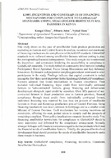| dc.contributor.author | Nyikal, Rose | |
| dc.contributor.author | Mburu, John | |
| dc.contributor.author | Kangai, Elosy | |
| dc.date.accessioned | 2014-07-22T05:59:27Z | |
| dc.date.available | 2014-07-22T05:59:27Z | |
| dc.date.issued | 2011-09 | |
| dc.identifier.citation | Optimimization of Agricultural Value Chains for sustainable Development | en_US |
| dc.identifier.uri | http://hdl.handle.net/11295/73217 | |
| dc.description | aGRO 2011 biennial conference presentation | en_US |
| dc.description.abstract | This study draws on the case of smallholder fresh produce production and
marketing in Eastern and Central Kenya to analyze incentives and constraints
of financing mechanisms for compliance to GlobalGAP standards. GlobalGAP
standards were enforced among smallholder farmers without putting in place
the corresponding financial arrangements. This study sought out to understand
the incentives and constraints hindering the accessibility to compliance to
GlobalGAP standards. The study relied on community-level surveys including
Participatory Rural Appraisal, Focus Group Discussions and Key Informant
Interviews. Systematic and purposive sampling procedures were used to select
participants in the study. Findings indicate that capital constraint is ranked
among the first three most important factor hindering GlobalGAP compliance.
Farmers adopted four broad mechanisms to finance compliance. These
included individual financing; input credit from individually contracted
farmers to 'sub-contracted' farmers, group financing and infrastructure
development alongside input credit by exporters. Over fifty percent of noncontracted
farmers in Buuri production area in Eastern province, financed
compliance through input credit from individually contracted farmers.
Individual financing was reported by less than ten percent of smallholder
farmers in Buuri and Kirinyaga production area of Central Province. Group
financing mechanism was most common in Kirinyaga and to a smaller extent
Mbooni of Eastern Province. Each mechanism has varying incentives and
constraints, affecting the cost, period taken to comply and the prospects of
remaining compliant. Three policy implications emanate from this study. First,
financing smallholder horticulture for compliance to GlobalGAP should be
more innovative and informed by the compliance arrangement. Secondly,
stronger linkages with financiers are encouraged to devise products which meet
the financial needs of smallholder farmers. Thirdly, the proposed horticultural
development fund should prioritize the needs of smallholder farmers to enable
them remain in business. | en_US |
| dc.description.sponsorship | National Council of Science and Technology, The Kenya Seed Company | en_US |
| dc.language.iso | en | en_US |
| dc.subject | Smallholder Horticulture | en_US |
| dc.subject | Constraints, | en_US |
| dc.subject | Incentives, | en_US |
| dc.subject | Financing, | en_US |
| dc.subject | GlobalGAP compliance, | en_US |
| dc.title | Incentives and constraints of financing mechanisms for compliance to globalgap standards among smallholder horticultural farmers in Kenya | en_US |
| dc.type | Presentation | en_US |
| dc.type.material | en | en_US |

